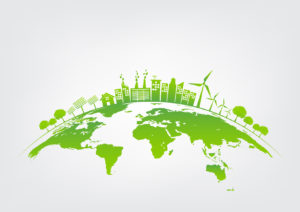 Constructing a building that is green is becoming increasingly popular. A green building seeks to increase energy efficiency, improve air quality, and minimize a building’s impact on its surrounding environment. These top building concepts will not only lead to the development of a trendy building, but also they will make your building eco-friendly.
Constructing a building that is green is becoming increasingly popular. A green building seeks to increase energy efficiency, improve air quality, and minimize a building’s impact on its surrounding environment. These top building concepts will not only lead to the development of a trendy building, but also they will make your building eco-friendly.
Earning the LEED Certification
Leadership in Energy and Environmental Design (LEED) is a program that was developed by the U.S. Green Building Council (USGBC), a non-profit that seeks to encourage property owners to develop energy efficient and environmentally friendly buildings. The LEED rating system standardizes green certification. It encourages the implementation of energy saving measures such as reducing a building’s water and energy usage, minimizing waste from the construction process, and improving a building’s indoor air quality. Additionally, LEED measures how a building’s green designs positively affect employee engagement and performance. LEED is a strong indicator of energy savings. LEED certified commercial buildings can have energy savings of 30% compared to non-LEED certified commercial buildings. On average, buildings that are designed with LEED certification in mind can see an average of 16% less water usage and an average of 11% less electricity usage. In some cases, LEED certification can also provide tax credits. While the savings that LEED certification provide are beneficial, LEED certification also improves your business.
Since LEED certification is earned, a building that gains LEED certification is legitimized in the eyes of the public. Consumers are becoming increasingly supportive of businesses that have green initiatives. Three in four consumers are willing to pay more for services and products that are offered by environmentally conscious businesses. For Generation Z, environmentally-conscious purchasing decisions are even larger: 72% of Generation Z reported that they are willing to spend more money with a business that is green. The oldest members of Generation Z are entering their early 20’s, making them a growing consumer population. LEED certification can improve a business’ image, minimize a business’ environmental impact, and help a property owner save money.
Radiant Heating and Cooling Systems
Traditionally, commercial buildings provide heat and air conditioning through forced-air systems. The downside to such systems, however, is that not only can they lack energy efficiency, but also they do not effectively keep a room warm or cool. Forced-air systems only regulate the temperature of the air inside of a room – they do not effectively affect the temperatures of anything else. Radiant heating and cooling systems, however, are both more energy efficient and better at heating and cooling a room. Radiant heating and cooling systems are often installed in the floor, though they can also be installed inside walls. Radiant systems warm or cool the floor itself, through the process of convection. For example, when using a radiant system to heat up a room, the room is warmed by heat that rises from the floor. Rather than simply warming the air, thermal comfort is achieved by warming the rooms’ contents and the people within it. A similar process allows a room to keep cool. Radiant systems are better at warming or cooling a room than forced-air systems.
Additionally, radiant systems do not spread allergens, something that forced-air systems cannot avoid. Radiant systems are better for a room’s air quality because they do not disrupt or displace a room’s airflow. Radiant systems are also silent, operating quietly out of sight. In commercial buildings, radiant systems outperform non-radiant warmed and cooled buildings by 67%. Radiant systems can save a business money as well. One study found that radiant heating saved an average of $22,000 annually. Compared to standard commercial buildings, this savings exceeds 60%. Radiant systems reduce air irritants and they are more efficient comfortably regulating a room’s temperature. Radiant systems are a growing green building trend due to their efficiency and improved comfort.
Green Roofs
A green roof is a roof that is designed to be partially covered by live vegetation. Green roofs come in two forms: extensive roofs and intensive roofs. An extensive green roof is low-maintenance and lightweight, making it structurally easy to support. These kinds of green roofs install vegetation that require minimal amounts of soil. Popular vegetation includes succulents and varieties of moss. Extensive green roofs, though, provide less benefits than intensive green roofs. An intensive green roof tends to bear more weight because it holds larger plants and requires more soil. Common intensive green roof vegetation includes perennials, grass varieties, shrubs, and ferns. Intensive green roofs provide larger environmental benefits due to their size. Green roofs provide many benefits to a commercial building.
Green roofs provide a natural way to divert storm water. Green roofs absorb runoff from rain, which lessens the impact on storm drains. Many of New Jersey’s storm water systems are aging. Repairing these systems is costly, however, so by lessening a building’s storm water impact, the storm water drains are provided reprieve. Green roofs also improve outdoor air quality. The vegetation can capture and recycle air pollutants that come from cars. A major complication arising from traditional roofs is that they often transfer large amounts of heat indoors, due to concrete and asphalt retaining heat for long periods of time. By planting vegetation on a roof, that heat transfer is minimized. The green roof insulates the building and absorbs excess heat. This, in turn, reduces energy costs that typically come from having to over-cool a building.
The installation of a green roof may cost more at the outset, however, it will be cheaper than a conventional roof over time. One estimate finds that a green roof can save approximately $200,000, with most of those savings – approximately two-thirds – coming from the reduced energy used to cool the building. A green roof also gives your building’s rooftop utility. By creating a green space, employees can enjoy a tranquil and semi-private break area. Being surrounded by nature is proven to reduce stress, so a green roof will also benefit employee health. By installing some patio furniture, a business can encourage employees to fully enjoy a green roof. Green roofs are a worthwhile investment due to their ability to reduce employee stress and improve a building’s energy efficiency.
Vertical Gardens
Also referred to as green walls or green facades, vertical gardens are similar to green roofs: rather than installing vegetation on top of your building, though, a vertical garden plants vegetation in a wall. While vertical gardens have been massively popular in Europe for a handful of decades, the trend is only now hitting the United States. The reason vertical gardens are becoming popular is because a major trend in green construction includes bringing more plant life indoors.
Vertical gardens require a support structure that is capable of holding the vegetation’s’ weight. There is a hidden gutter that is installed at the bottom of the wall, so that the water used to hydrate the plant life can be recycled. Typically, vertical gardens feature ferns or flowers, but some even grow vegetables. Some vertical walls feature easy-to-care for vegetation such as ivy or succulents. Vertical walls can be installed on the interior or exterior of a building. These two installation types feature different benefits.
Exterior vertical gardens can reduce the urban heat island effect as well as reduce a building’s energy consumption. The urban heat island effect is the result of urban living. Construction materials used in urban settings – e.g. asphalt, concrete, and brick – displace heat over the course of a day, often making an area hotter than its surrounding climate. Vertical gardens that are planted outside of a building are capable of having similar positive effects to that of a green roof: they absorb and distribute excess heat, filter out air pollutants, and provide a pleasing aesthetic to your building. A vertical garden can save upwards of 18% of energy used towards keeping a commercial building cool. Exterior vertical gardens are simply more public than green roofs. They are a great alternative to green roofs, since they provide many of the same benefits.
Interior vertical gardens can improve a building’s indoor air quality. While radiant heating and cooling systems do not displace air pollutants the way forced-air systems do, radiant systems also cannot filter the air. Indoor vertical gardens can be used to hide unsightly construction elements, or they can be used as a natural partition. Indoor vertical gardens can promote a stress-free environment as well as improve the indoor air quality in a natural way. Indoor vertical gardens can help keep a room naturally cool during the day, due to vegetation providing direct shade. Vertical gardens can make a building more thermally efficient. This trend in green construction continues to grow in popularity due to its ease of maintenance and multitude of benefits.
When designing your next commercial building, be sure to keep LEED certification standards in mind. All of these green trends can work towards a building earning LEED certification. While some green concepts may cost more at the outset, they will pay for themselves over time. Green building concepts are more than a mere fad. By improving a building’s energy efficiency, air quality, and impact on its surrounding environment, the building benefits both its employees and clients, as well as its neighborhood.

